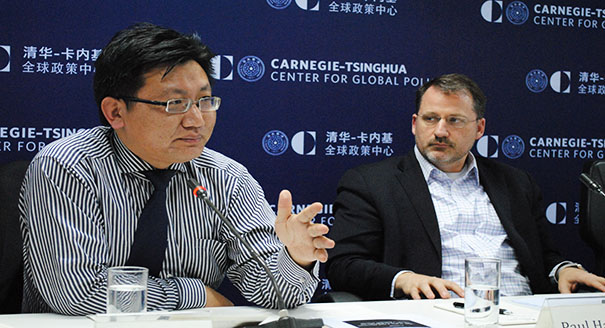Registration
You will receive an email confirming your registration.
China’s Belt and Road initiative aims to extend infrastructure and connectivity across Eurasia from the Asia-Pacific to Europe. It includes the overland Silk Road Economic Belt across Central Asia and the Twenty-First-Century Maritime Silk Road, which will span Southeast Asia. Since Chinese President Xi Jinping announced these initiatives in 2013, they have been actively discussed both within China and abroad. So far, however, few infrastructure projects have been enacted and the proposal remains at an early stage.
Carnegie–Tsinghua’s Zhao Kejin has released a Chinese-language book entitled The Belt and Road Initiative: From Vision to Actions, which lays out recommendations for enacting this ambitious initiative. Gong Ting of the China Institute of International Studies moderated a discussion with Zhao and other U.S. and Chinese experts about the prospects of the Belt and Road to reshape patterns of economic activity and build greater connectivity across Eurasia.
Discussion Highlights
- Defining the Belt and Road’s Purpose: Panelists noted that although the Belt and Road initiative has triggered spirited discussions both inside and outside of China, an overarching consensus on precisely what it will entail has proven elusive. They observed that this has produced a multitude of different narratives about what purpose the Belt and Road is meant to serve. Some participants described it as an active form of win-win diplomacy meant to cultivate trade and economic connectivity between China and neighboring countries. Others pointed out that the initiative also epitomizes China’s attempt to create momentum for domestic economic reforms. Participants concluded that the motives behind the initiative will become clearer as more individual projects are unveiled.
- What the Belt and Road Will Do: Some of the confusion about what the Belt and Road will do may stem from the multifaceted effects that the initiative is expected to have. One speaker noted that this initiative will broaden the scope of China’s economic engagement with other developing countries, leading to expanded trade flows, greater job opportunities, and heightened investment on a continental scale across Eurasia. Panelists also observed that the Belt and Road may help China to mitigate some challenges to the country’s economic development model by offering opportunities to reduce wealth and infrastructure discrepancies between affluent coastal areas and more impoverished inland communities. The Belt and Road Initiative may also allow China to offload excess capacity in struggling domestic industries such as construction and steel manufacturing, speakers noted. Finally, they stated that this initiative may help China address cross-border nontraditional security challenges, such as ensuring secure energy supplies and combatting terrorism.
- An Inclusive Vision: The success of the Belt and Road initiative will depend nearly as much on the efforts of partnering countries as it does on China’s implementation, given that Beijing views the plan as a hallmark of its active foreign policy. Speakers stressed that the Belt and Road is an open, inclusive initiative that welcomes all countries to participate in mutually beneficial interactions based on a vision of common development that bears fruits for all parties. They asserted that this vision is meant to deepen China’s partnerships with great powers like the United States and the European Union as well as developing countries throughout Central Asia, Southeast Asia, and even further afield.
- Financing the Belt and Road: To provide funding for the infrastructure projects associated with the Belt and Road initiative, participants explained that China has helped establish several new domestic and multilateral financial institutions. China has allocated billions of dollars through entities such as the Silk Road Fund, the Asian Infrastructure Investment Bank, and the New Development Bank to support these building projects. One panelist also stated that a number of these investment projects across Eurasia will be undertaken in coordination with existing institutions such as the World Bank and the International Monetary Fund.
- Remaining Challenges Ahead: Panelists acknowledged that the Belt and Road initiative remains at an early stage of development. They noted that the initiative is very ambitious in scale and that a number of challenges must be navigated for it to succeed. The grand size of the Belt and Road vision necessitates that the different actors involved in the project must coordinate their efforts , including China’s National Development and Reform Commission, its Ministry of Commerce, its Ministry of Foreign Affairs, and provincial governments, as well as multilateral organizations such as the Asian Infrastructure Investment Bank and the New Development Bank. Speakers also stated that the projects that this initiative involves are based in developing countries associated with a relatively high degree of political risk. In addition, they added, China will need to make great efforts to enhance its understanding of local conditions in a diverse range of countries and how these factors may affect the prospects of a given project.
Zhao Kejin
Zhao Kejin is a resident scholar at the Carnegie–Tsinghua Center and deputy director of Tsinghua University’s Center for U.S.-China Relations.
Pierce Davis
Pierce Davis is an economic officer at the U.S. Embassy in Beijing. He previously served as a diplomat in Afghanistan and South Africa.
Paul Haenle
Paul Haenle is the director of the Carnegie–Tsinghua Center for Global Policy based at Tsinghua University.
Zhao Minghao
Zhao Minghao is a research fellow at the China Center for Contemporary World Studies. He is also a full member of the China National Committee of the Council for Security Cooperation in the Asia Pacific.
Gong Ting
Gong Ting is an assistant research fellow at the China Institute of International Studies.
